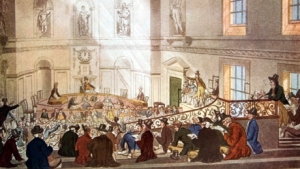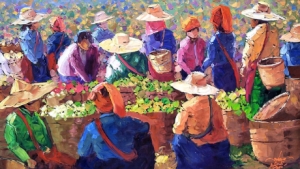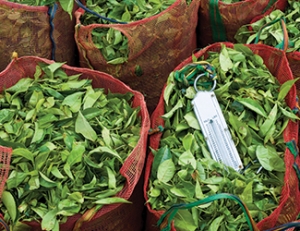A Brief History
Discover the ancient origins and fascinating history of tea!
For loose-leaf packets, the blended tea is put into a hopper which feeds a machine that carefully measures and dispenses the right amount of tea into the packet, filling it and sealing it, and weighing it as a final check. This is all done automatically in seconds.
Tea bag tea is fed into specially designed machines which will fill thousands of teabags, be they round, square or pyramid shaped, each minute. Each bag usually contains at least 2.27gms of tea and is hermetically sealed, then packed into cartons.
Speciality teas, that is a blend of teas which take their name from a growing area, time of day or person's name, are blended in just the same way, but there are not so many teas in any one blend of speciality tea as there are in a popular blend.
The tea packaging companies sell their tea to the supermarkets, and other retailers using a national accounts system, through wholesalers and even by a team of salesmen calling on corner shops.
Your tea reaches the supermarket or shop shelf between 20 to 30 weeks after it has been plucked on the estate or smallholding.
To see a list of companies and organisations involved in the journey from estate to cup, go to the Tea Directory section of the website.
 Tea is sold in a variety of ways. Tea may be sold at auction in countries of origin. There are international auction centres in Mombasa in Kenya, Colombo in Sri Lanka and Limbe in Malawi. India has auction centres in the north and south. Indonesia sells tea in Jakarta. China sells her tea by numbered standards at commodity fairs at Guangzhou.
Tea is sold in a variety of ways. Tea may be sold at auction in countries of origin. There are international auction centres in Mombasa in Kenya, Colombo in Sri Lanka and Limbe in Malawi. India has auction centres in the north and south. Indonesia sells tea in Jakarta. China sells her tea by numbered standards at commodity fairs at Guangzhou.
Tea prices are governed by quality, supply and demand. Tea brokers act as intermediaries and taste, value and bid on their client's behalf. Tea may also be sold from the tea garden by private sale or at offshore auction whilst on route to its destination. After its arrival in Britain, the tea is taken to the various packaging companies for blending and packing.
The wooden tea chest dates back to the 17th Century, established as the best way to store and protect tea on its long sea voyage from China or India to Britain and America. It continued to be the standard 'package' until the advent of containerisation, which revolutionised the way in which all manner of goods were transported around the world. This also coincided with a shortage of wood in some of the tea producing countries, which signalled the demise of the tea chest on economic grounds.
 In the late 1970’s, the Packaging Sub - Committee of the UK Tea Trade Technical Committee set up a project, led by Bob David (Brooke Bond Plantations Division), to develop an alternative package. This had to be of a size and shape to allow easy palletisation, and provide the required barrier properties to protect the tea from deterioration in transit and storage.
In the late 1970’s, the Packaging Sub - Committee of the UK Tea Trade Technical Committee set up a project, led by Bob David (Brooke Bond Plantations Division), to develop an alternative package. This had to be of a size and shape to allow easy palletisation, and provide the required barrier properties to protect the tea from deterioration in transit and storage.
The multiwall paper sack was an established format for palletisation, so the Committee worked with the Packaging Industry Research Association (PIRA) to develop the specification for the tea sack.
The surface of the inner ply, in contact with the tea, had to have a coating which would prevent the ingress of moisture, and any external atmospheric contaminant.
There was a specific risk arising from the wooden pallets themselves. Many of them were treated with the wood preservative pentachlorophenol, when the wood is damp, microbial growth converts the chlorophenols to chloroanisoles, which are detectable as taint at extremely low concentrations (e.g. .01ppm). The possibility that this taint could develop in a container, full of tea is obvious.
 The trial sacks were 5-ply Kraft paper with polyethylene - bonded aluminium foil on the contact surface of the inner ply. The dimensions were determined by the requirement to fit a 4-way entry 1120mm.x1120mm. flat flush ended pallet to fit the unit load size of 1140mm.x1140mm. specified in ISO 3676.
The trial sacks were 5-ply Kraft paper with polyethylene - bonded aluminium foil on the contact surface of the inner ply. The dimensions were determined by the requirement to fit a 4-way entry 1120mm.x1120mm. flat flush ended pallet to fit the unit load size of 1140mm.x1140mm. specified in ISO 3676.
Permeability tests on a number of samples of the inner aluminium/ polyethylene/kraft ply, carried out at the PIRA laboratories, to assess the barrier properties to moisture and 2.4.6. trichloroanisole were successful. In 1983 shipping trials were arranged with Brooke Bond Kenya from their plantations in Kericho. A single invoice of tea was split 50:50 between tea chests and the trial sacks. These were loaded into separate containers, and recorders to measure temperature and humidity placed in each container. The containers were shipped from Mombasa to Southampton, transferred to the Banbury warehouse, the pallets unloaded and the recorders recovered. The recorded data was extracted at Unilever Research Laboratories, Colworth House, and told us how the conditions in the containers changed during that journey from equatorial Africa to the UK.
Samples were taken from the chests and the sacks, and comparative tasting tests carried out at the Tea Auction House in London by tea buyers based in the area. Statistical analysis of the results showed no significant difference between the samples.
Further trials were carried out at Kericho to establish and specify the procedures for filling and sealing the sacks, 'squaring off' so they formed a stable geometric stack on the pallet, and applying the plastic sheet which was spiral wound around the palletised sacks to hold them in place.
With the practical work completed, the next stage was to prepare the tea sack specification for submission to become an international standard.
This was done by ISO/TC34/SC8 Tea, the Secretariat for this Committee was held by the UK, chaired by Dr. Peter Collier (Unilever Research, Colworth House) under the aegis of the British Standards Institute.
The first draft standard was tabled at the full Committee Meeting during Sept. 1989 in Jakarta. Several issues were raised, to be addressed at the next meeting in April 1992 in Istanbul, further discussion did not reach a conclusion, but the specification was approved at the London meeting in 1994, leading to the issue of:
ISO 9884-1: 1994 (en) Tea Sack Specification
Part 1: Reference sack for palletized and containerized transport of tea
Part 2: Performance specification for sacks for palletized and containerized transport of tea
This remains the International Tea Sack Standard.
Dr N.C. Robson, UK Tea Trade Technical Committee 1981-93.